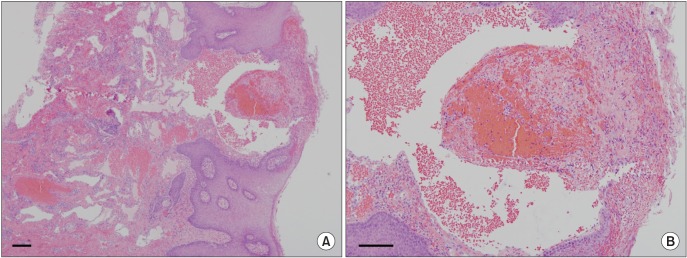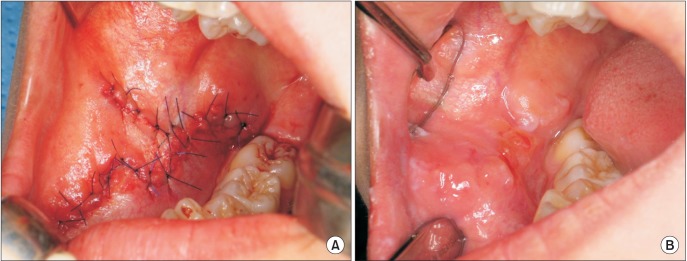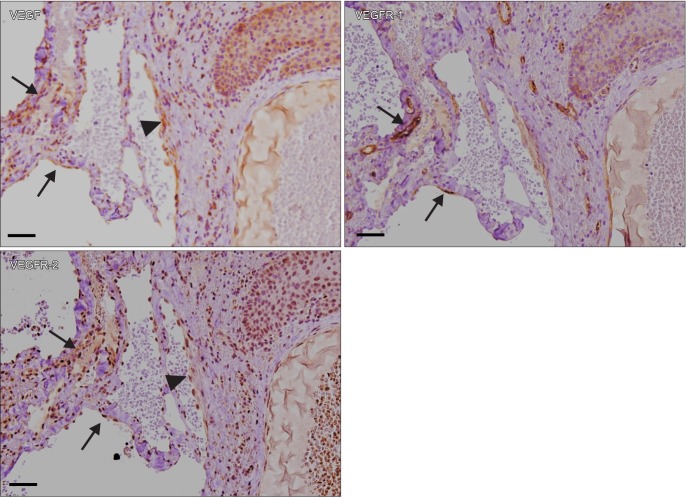J Korean Assoc Oral Maxillofac Surg.
2014 Oct;40(5):240-245. 10.5125/jkaoms.2014.40.5.240.
Angiokeratoma circumscriptum of the buccal mucosa: a case report and literature review
- Affiliations
-
- 1Department of Oral and Maxillofacial Surgery, Gyeongsang National University School of Medicine, Jinju, Korea. parkbw@gnu.ac.kr
- KMID: 2005454
- DOI: http://doi.org/10.5125/jkaoms.2014.40.5.240
Abstract
- Angiokeratoma is a benign cutaneous lesion of the capillaries, presenting as dilated vessels in the upper part of the dermis. Although this disorder is classified into various types and has been occasionally reported in the skin of the scrotum or extremities, the involvement of the oral cavity mucosa has been rarely reported. The present study reports a case of angiokeratoma circumscriptum in the buccal mucosa. The expression of vascular endothelial growth factor (VEGF) and both of its receptors (VEGFR-1 and VEGFR-2) was demonstrated by immunohistochemistry in the endothelial cells lining the dilated vessels. The expression of VEGFR-2 was higher than that of VEGFR-1 in the endothelial cells in the lesion, indicating an increased rate of endothelial cell proliferation within the lesion. Interestingly, some of the endothelial cells co-expressed VEGF and its two receptors. These results suggest that endothelial cells in the pathologically dilated vessels possess VEGF autocrine growth activity involved in vasculogenesis and maintenance in angiokeratoma lesions. To our knowledge, this is the second report published on isolated oral angiokeratoma confined to the buccal mucosa and the first case report on angiokeratoma circumscriptum involving the buccal mucosa.
MeSH Terms
-
Angiokeratoma*
Capillaries
Dermis
Endothelial Cells
Extremities
Immunohistochemistry
Mouth
Mouth Mucosa*
Mucous Membrane
Scrotum
Skin
Vascular Endothelial Growth Factor A
Vascular Endothelial Growth Factor Receptor-1
Vascular Endothelial Growth Factor Receptor-2
Vascular Endothelial Growth Factor A
Vascular Endothelial Growth Factor Receptor-1
Vascular Endothelial Growth Factor Receptor-2
Figure
Reference
-
1. Schiller PI, Itin PH. Angiokeratomas: an update. Dermatology. 1996; 193:275–282. PMID: 8993949.
Article2. Ozdemir R, Karaaslan O, Tiftikcioglu YO, Kocer U. Angiokeratoma circumscriptum. Dermatol Surg. 2004; 30:1364–1366. PMID: 15458538.
Article3. Vijaikumar M, Thappa DM, Karthikeyan K, Jayanthi S. Angiokeratoma circumscriptum of the tongue. Pediatr Dermatol. 2003; 20:180–182. PMID: 12657024.
Article4. Varshney S. Angiokeratoma circumscriptum of the tongue. Int J Dermatol. 2005; 44:886–888. PMID: 16207201.
Article5. Sion-Vardy N, Manor E, Puterman M, Bodner L. Solitary angiokeratoma of the tongue. Med Oral Patol Oral Cir Bucal. 2008; 13:E12–E14. PMID: 18167473.6. Leung CS, Jordan RC. Solitary angiokeratoma of the oral cavity. Oral Surg Oral Med Oral Pathol Oral Radiol Endod. 1997; 84:51–53. PMID: 9247950.
Article7. Kumar MV, Thappa DM, Shanmugam S, Ratnakar C. Angiokeratoma circumscriptum of the oral cavity. Acta Derm Venereol. 1998; 78:472. PMID: 9833054.8. Bhargava P, Bhargava S, Mathur D, Agarwal US, Bhargava R. Angiokeratoma of tongue. Indian J Dermatol Venereol Leprol. 2001; 67:270. PMID: 17664774.9. Siponen M, Penna T, Apaja-Sarkkinen M, Palatsi R, Salo T. Solitary angiokeratoma of the tongue. J Oral Pathol Med. 2006; 35:252–253. PMID: 16519775.
Article10. Patigaroo S, Khan N, Manzoor S, Gupta N, Jain P, Shakeel M. Isolated multiple angiokeratoma of tongue--a case report and review of literature. Int J Pediatr Otorhinolaryngol Extra. 2012; 7:126–128.
Article11. Green JB, Roy S. Angiokeratoma circumscriptum of the dorsal tongue in a child. Int J Pediatr Otorhinolaryngol Extra. 2006; 1:107–109.
Article12. Erkal EY, Karabey MS, Vural Ç, Mutlu F, Aksu G, Sarper B, et al. Solitary angiokeratoma of the tongue in an adult patient treated with intensity modulated radiation therapy. Am J Otolaryngol. 2013; 34:582–585. PMID: 23410904.
Article13. Mittal R, Aggarwal A, Srivastava G. Angiokeratoma circumscriptum: a case report and review of the literature. Int J Dermatol. 2005; 44:1031–1034. PMID: 16409270.
Article14. Fabry J. Uber einen fall von angiokeratoma circumscriptum am linken oberschenkel. Derm Z. 1915; 22:1–4.15. Kobayashi T, Sakuraoka K. A case of angiokeratoma circumscriptum: immunolocalization of matrix metalloproteinase (MMP)-9. J Dermatol. 1998; 25:391–394. PMID: 9675347.
Article
- Full Text Links
- Actions
-
Cited
- CITED
-
- Close
- Share
- Similar articles
-
- A Case of Post-Injury Angiokeratoma Circumscriptum of the Chest
- Solitary angiokeratoma developed in one area of lymphangioma circumscriptum
- Angiokeratoma Circumscriptum: Successful Treatment with the Flashlamp Pulsed Tunable Dye Laser
- Nevus Flammeus Associated with Angiokeratoma of Fordyce and Lymphangioma Circumscriptum
- Lymphangioma circumscriptum on buccal mucosa: a case report





